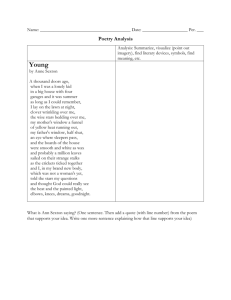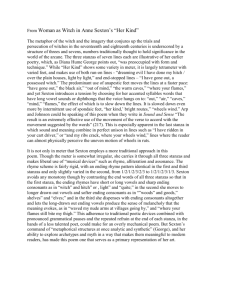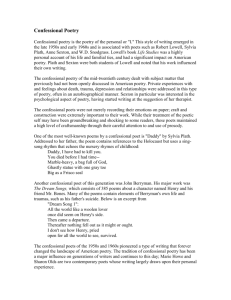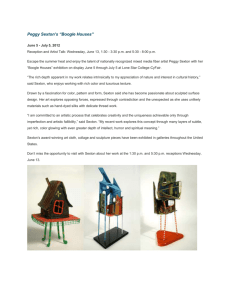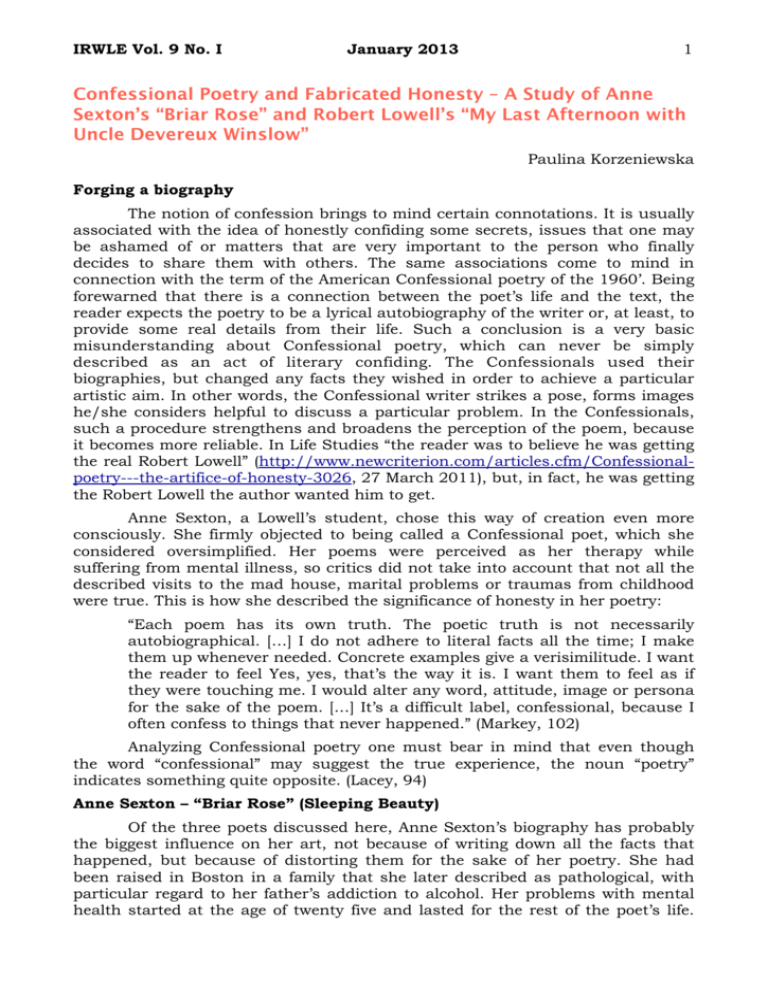
IRWLE Vol. 9 No. I
January 2013
1
Confessional Poetry and Fabricated Honesty – A Study of Anne
Sexton’s “Briar Rose” and Robert Lowell’s “My Last Afternoon with
Uncle Devereux Winslow”
Paulina Korzeniewska
Forging a biography
The notion of confession brings to mind certain connotations. It is usually
associated with the idea of honestly confiding some secrets, issues that one may
be ashamed of or matters that are very important to the person who finally
decides to share them with others. The same associations come to mind in
connection with the term of the American Confessional poetry of the 1960’. Being
forewarned that there is a connection between the poet’s life and the text, the
reader expects the poetry to be a lyrical autobiography of the writer or, at least, to
provide some real details from their life. Such a conclusion is a very basic
misunderstanding about Confessional poetry, which can never be simply
described as an act of literary confiding. The Confessionals used their
biographies, but changed any facts they wished in order to achieve a particular
artistic aim. In other words, the Confessional writer strikes a pose, forms images
he/she considers helpful to discuss a particular problem. In the Confessionals,
such a procedure strengthens and broadens the perception of the poem, because
it becomes more reliable. In Life Studies “the reader was to believe he was getting
the real Robert Lowell” (http://www.newcriterion.com/articles.cfm/Confessionalpoetry---the-artifice-of-honesty-3026, 27 March 2011), but, in fact, he was getting
the Robert Lowell the author wanted him to get.
Anne Sexton, a Lowell’s student, chose this way of creation even more
consciously. She firmly objected to being called a Confessional poet, which she
considered oversimplified. Her poems were perceived as her therapy while
suffering from mental illness, so critics did not take into account that not all the
described visits to the mad house, marital problems or traumas from childhood
were true. This is how she described the significance of honesty in her poetry:
“Each poem has its own truth. The poetic truth is not necessarily
autobiographical. […] I do not adhere to literal facts all the time; I make
them up whenever needed. Concrete examples give a verisimilitude. I want
the reader to feel Yes, yes, that’s the way it is. I want them to feel as if
they were touching me. I would alter any word, attitude, image or persona
for the sake of the poem. […] It’s a difficult label, confessional, because I
often confess to things that never happened.” (Markey, 102)
Analyzing Confessional poetry one must bear in mind that even though
the word “confessional” may suggest the true experience, the noun “poetry”
indicates something quite opposite. (Lacey, 94)
Anne Sexton – “Briar Rose” (Sleeping Beauty)
Of the three poets discussed here, Anne Sexton’s biography has probably
the biggest influence on her art, not because of writing down all the facts that
happened, but because of distorting them for the sake of her poetry. She had
been raised in Boston in a family that she later described as pathological, with
particular regard to her father’s addiction to alcohol. Her problems with mental
health started at the age of twenty five and lasted for the rest of the poet’s life.
IRWLE Vol. 9 No. I
January 2013
2
Sexton suffered from manic depression, countless nervous breakdowns and
bipolar disorder – a psychiatric illness that influences the patient’s mood
changing it from ecstatic to depresive. Her psychiatrist encouraged her to write in
order to improve her condition and the poems that she created in the mental
hospital are considered the best in her career. (Markey, 103.) Throughout the
long and complex treatment Sexton underwent hypnosis, which was one of the
causes for false memory, which means that she believed she experienced things
that had never happened. One of the very ambiguous and controversial topics of
her writing is the sexual abuse that allegedly took place when she was a girl.
Even though the family, friends and doctors deny such a supposition, Anne
Sexton made her readers believe it happened and had a strong impact on her life
and art. This proves that an interpretation of Confessional poetry may be very
equivocal, because, firstly, the readers are never sure that the described episode
did not take place and, secondly, they must be aware that it may be another pose
and creation the poet chose to present herself.
The problem of incest is one of the themes in the book Transformations.
Sexton used there a few figures from fairy tales by the Brothers Grimm and
presented her own vision of these stories. Famous female characters like
Cinderella or Snow White are put into a social and feminist context which
transforms the traditional gender image. One of such transformations is the
poem “Briar Rose”.
The first stanza presents an image of a girl which is not introduced as
Briar Rose yet. She is under hypnosis (that may be the reference to Sexton’s
experience from the mental hospital) – confused and defenseless. The author
indicates that such a condition brings her back to her early childhood: two years
old sucking her thumb, struggling into her mother’s pocketbook. Sexton
compares this experience to being on a voyage and suddenly getting stuck in a
time machine. This image is interrupted by the tender utterance of her father –
Little doll child,/ come here to Papa. These, at first sight, innocent words sound
however quite distressing in comparison to the frightened child and become
vulgar and obscene at the beginning of the second stanza, which leaves no
illusion that the speaker brings up a subject of incest and sexual abuse.
The next three parts are devoted to telling the tale of Sleeping Beauty.
Sexton starts from the moment of christening the girl and the reception where
twelve fairies were invited by the king. An important motif of this section of the
text is the thirteenth fairy for whom there was not any gold plate. She is
described rather as a witch; the black character that usually stands in opposition
to the main figures in fairy tales – her eyes burnt by cigarettes, her uterus an
empty teacup. This thirteenth fairy expresses Sexton’s objection to the traditional
image of woman in such stories, who is usually a beautiful submissive, tender,
kind-hearted girl waiting for the love of her life. Sexton’s witch seems to be an
outsider (with the unfortunate number thirteen, in addition) among the perfect
fairies. She comes with the prophecy, just as in the Grimms’ fairy tale, but the
poet adds a modern cultural symbol which is the painting by Munch – “The
Scream” presenting a suffering and scared figure.
The problem of incest comes back in the third stanza. Briar Rose is called
here a teenage goddess and her father does everything to keep her from the
coursed spinning wheel. He does not let her meet any men, being the only one in
her nearness. A very pejorative designation is used here: she dwelt in his odor,
IRWLE Vol. 9 No. I
January 2013
3
which suggests the sick relationship between the parent and his daughter. The
notion of a honeysuckle is also given here which is repeated in the text and which
usually gives positive connotations – a plant that has a sweet smell. Sexton’s
honeysuckle is, however, nauseating rather than sweet. By means of this image
the author states her opinion about fairy tales as a whole – they are sugary and
have nothing to do with real life.
The fourth stanza gives the picture of what happened when Sleeping
Beauty pricked herself on the spinning wheel. Everything grew still and the
vocabulary from the first stanza is repeated – stuck in a time machine, trance. One
may have an impression that Sexton compares the course of falling asleep to her
mental hospital traumas; catatonia, a mental illness, is also mentioned here.
Many princes tried to get inside, but they had not scoured their tongues which is
the reference to the previous toxic behavior of the father. Finally, after one
hundred years, the prince kissed Briar Rose, as in the fairy tale, but instead of
the happy end, the story continues. Sleeping Beauty wakes up crying as small
children woken up from a nightmare. What is more, the girl calls her father which
indicates that she is afraid of him – that is a return to the main problem of this
poem which is incest.
The fifth stanza presents Briar Rose’s life after she has married the prince.
The poet underlines that she is afraid of sleep, so one can assume that the sleep
symbolizes the memories of father and the trauma she received from him.
Sleeping Beauty is not a fairy tale character any more, she becomes a true-born
woman. She suffers from insomnia and cannot be happy with her husband,
because her past and all the frightful events come back and preclude her from
adult life. This is the reference to the implications that sexual abuse has on
women; it is a stamp that can never be removed from the psyche. The image of
the thirteenth fairy returns as well – at the end of the fifth stanza she may
represent not only the unconventional model of a woman but also the poet’s
mother by whom she felt betrayed. Sexton blamed her for not reacting to the fact
that her daughter was molested (Middlebrook, 57). The author’s mother is
believed to have been afraid of the divorce, which is why she never decided to
help her child (she eats betrayal like a slice of meat). In the sixth stanza the
author gives an image of Briar Rose’s stupefaction and helplessness towards her
life. She is unresponsive to outward things. The name of a drug is given here –
the medicine that is given to patients with mental problems. Again, Sexton’s
experience may have been the basis of this confession. The persona seems to be
in a trance, but if you kissed her on the mouth […] she’d call out: Daddy! Daddy!
Presto! She’s out of prison. The kiss from the Grimm’s story that indicates a new
chance for Sleeping Beauty for the happy end becomes ironic here. Even though
she is awake, which symbolizes her entering adult life, she is still in the prison of
her childhood memories and childhood that has been marked by sexual abuse.
Crucial to the question how much Sexton’s biography influenced her
poetry, is the last stanza of “Briar Rose”. The narrator reveals her own voice –
That much I am told, I was forced, I was passed. It is a direct story told by the
abused girl who describes her drunk father molesting her every night. He is
presented here as the worst enemy, a scary antagonist from whom there is no
escape. The author wonders in this conclusion what life after such experiences is,
whether adultery is the breaking-free from the defenselessness of a small child –
IRWLE Vol. 9 No. I
January 2013
4
the life after death. The rhetorical question the reader is left with gives no
illusions – sexual abuse leaves the stigma one can never get rid of.
IRWLE Vol. 9 No. I
January 2013
5
Robert Lowell – “My Last Afternoon With Uncle Devereux Winslow”
The second example of forging biography in poetry of Confessionals is
Lowell’s “My Last Afternoon With Uncle Devereux Winslow”.
The first poem of Life Studies has been not incidentally chosen as the
initial one. “My Last Afternoon…” is a highly personal text that describes, in fact,
Lowell’s family life and his true memories from childhood. What is more, the
author scrupulously specified names, dates and places, which makes the poem
even more plausible. Lowell, however, “admits to having invented facts in order to
give the whole a greater coherence – but the seeming factual precision gives the
poem the impression of being true” (Axelrod, 112). What is interesting and
unusual about the text in comparison to other ones created by Lowell, “My Last
Afternoon…” had been first a piece of prose, rewritten later and put into verse.
The annalistic exactness appears at the very beginning of the text, where
the date and the place are given – in 1922 Lowell was five years old and it sounds
convincing that he may have spent summer holidays at his grandfather’s. The
first part of the actual poem begins with the little boy’s quarrel with his parents
and the idyllic images of nature called from the speaker’s memory: alley of
poplars, rose garden, virgin pine. The first two stanzas suggest a duality of the
speaker – he appears in the text both as a child and as an adult poet, using
children’s expressions (Tockytock, tockytock) and contrasting formulations typical
of adults and their knowledge about the world (Alpine, Edwardian cuckoo clock)
(Axelrod, 115). Consequently the poem is read in two ways: as memories from
childhood and as a commentary of an adult man. The illusion of authenticity of
these memories is even more enhanced by the last word of the second stanza (All
about me), where the author use enjambment to strengthen the impression of
confession.
The two last stanzas of the first part are speaker’s recollection of his
grandfather and his house. These reminiscences seem very personal: they reveal
the grandfather’s origins (his high school at Stuttgart am Neckar), precisely
describe the farm and the décor of the house. These stanzas summon the adult
speaker’s smells and tastes from childhood: oranges, mint, shandygaff,
sarsaparilla, present the new figures: Sadie and Nellie who can be perceived by
the reader as the speaker’s sisters or cousins, names of the grandfather’s
children, which are the real names of Lowell’s family members: Charlotte (the
author’s mother), Devereux and Sarah. Finally, the last stanza of this part
announces the real topic of the poem: death in the reception of a small child. His
reaction is typical of a five-year-old boy – the only death he had ever seen was the
death of a puppy.
The second, only one-stanza part, underlines again the speaker’s age and
suggest the deduction that the persona of the poem is Lowell himself. The image
given is that of a boy dressed up in his Sunday best and his reflection on how
unnatural he feels in this outfit (I was a stuffed toucan with a bibulous,
multicolored beak.); even the name of the clothes shop is mentioned (Rogers Peet’s
boys’ store) to make this image more realistic. Such a procedure is characteristic
of Life Studies – Lowell put in his poems the names of stores, places, symbols of
American daily life of the first part of the twentieth century. The aim of this short,
descriptive stanza is also to create a tension that something is about to happen.
IRWLE Vol. 9 No. I
January 2013
6
The third part is devoted to the image of Aunt Sarah. She is presented as
a bit neurotic and pathetic music amateur practicing on the fake piano to spare
the nerves of her mother. The adult Lowell’s sense of humor and irony are
perfectly seen here – he describes her archaic Athenian nose and the fact that she
forgot to appear on her recital day. Thanks to the character of Aunt Sarah “My
last afternoon…” becomes an ironic story of the family, including its defects and
“failures normally kept politely hidden” (Axelrod, 113). The next stanza at the
beginning of the last, fourth part before introducing the title character, uncle
Devereux Winslow, comes back again to the perception of a child and his
experience and expectations from life. What in the world was I wishing? […] A fluff
of the west wind puffing/ my blouse, which is distant from what the boy will go
through because of his uncle’s death. In this stanza, the speaker tells a short
story about his uncle hunting for ducks. He calls him a single sculler who was
quacking to the decoys, which may be with reference to his later illness that
suddenly took his life away. The figure of Uncle Devereux is further described in
the following stanza. It is revealed that he was a volunteer Canadian officer, a bit
infantile and disorganized (his student posters, tackled helter-skelter on walls as
raw as a board walk). The posters depict a comic figure, historical facts, beautiful
women and soldiers bushwhacked on the veldt – again the motive of being
surprised and captured, a metaphor for Devereux’s death. To make it more real,
the figures on the poster were almost life-size.
The first direct notion about uncle’s past away appears in the next stanza.
My uncle was dying at twenty-nine. This information agrees with Lowell’s family
story – indeed Devereux Winslow died at this age, but the Hodgkin’s disease,
which is also mentioned in the poem, is put there to confer the authenticity. The
text reveals that he orphaned three daughters and went for his last trip with his
wife. This last honeymoon, actually, is a pretext for the speaker to externalize the
feeling from his past – the five-year-old boy’s fear from what is incomprehensible
for children. Nevertheless, the narrator of this part is indisputably an adult,
comparing his image from childhood to Agrippina, an ancient figure. The
exactness of the following lines are again to prove that all the described images
and situations really took place in Lowell’s life: the date of 1911 and measuring of
uncle Devereux.
The last verses of the text confirm its sentimental character and the
importance of images. These lines present the small speaker who sees the dead
uncle in his mind’s eye and describes him very precisely – His face was putty./
His blue coat and white trousers/ grew sharper and straighter. The image from the
second stanza is repeated here – piles of earth and lime. Metaphorically, these
piles symbolize death and life, darkness and brightness, coldness and warmth.
The boy plays with these piles unaware of seriousness of what happened to his
uncle.
This ‘untypical’ of Lowell’s poem (its prose-like character) is, however,
typical of Life Studies. “My Last Afternoon…” inscribes in family stories that have
been changed or reconstructed to achieve the artistic aims or simply the
coherence needed to make the poem more plausible.
IRWLE Vol. 9 No. I
January 2013
7
It may be concluded that Confessional poetry cannot be more challenging
in terms of the thorough understanding of its’ authors intentions. They seem to
trigger with the audience revealing only the details they want to reveal, but,
simultaneously one can never be sure whether it is not only a literary pose. Such
ambiguities, however, contribute to the unabated popularity of the trend.
WORKS CITED
Axelrod, S. G. Robert Lowell. Life and Art. New Jersey. Princeton University Press,
1979.
Colburn, Steve, ed. Anne Sexton: Telling the tale. The University of Michigan
Press. 1988.
Lowell, Robert. Life studies. London: Faber and Faber, 2001.
Markey, Janice. A new tradition? The poetry of Sylvia Plath, Anne Sexton, and
Adrienne Rich, a study of feminism and poetry. Frankfurt am Main and New
York. Peter Lang, 1985.
Middlebrook, Diane. Anne Sexton: A biography. New York. Vintage Books. 1992
Wood Middlebrook, Diane, and Hume George, Diana, eds. The selected poems of
Anne Sexton. New York. Mariner Books, 2000.
Yezzi, David. “Confessional poetry and the artifice of honesty”, The New Criterion,
20 December 2010: http://www.newcriterion.com/articles.cfm/Confessionalpoetry---the-artifice-of-honesty-3026
Ms. Paulina Korzeniewska
Masters Student – Department of English
Adam Mickiewicz University
Poznan, Poland



